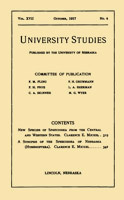University Studies of the University of Nebraska
Date of this Version
5-1957
Citation
1957 by The University of Nebraska Printed in the United States by the University ot Nebraska Printing Division
Abstract
The existing studies of the poetry of Erich Kiistner deal almost exclusively with aspects of its content, whether in an ideational or a concrete sense, and have at best only peripheral reference to the esthetic realization of this content. That is, these studies consider the poems primarily in their function as means of communication or even as unwitting autobiography, and in effect ignore the poems in order to "penetrate" to that which they communicate or reveal.
Yet the relation of external and internal in any esthetic object is just the reverse: one would have to penetrate past that which the poems communicate or reveal, as being external to them, to the poems as independent esthetic objects. For the sole distinguishing characteristic of poems and all other successful esthetic creations is that they ultimately communicate themselves purely and exist as values entirely aside from the potentiality of possessing some function. Hence abstract art is not only manifested in fairly clear examples but must be considered to be omnipresent as the invisible ultimate component of. the most concrete or representational art, and just so the dance may be considered to exist in abstraction from the dancers as the configuration of their movements, whereas no nonesthetic means of com~ munication embodies a corresponding abstraction which would be of absolutely independent value. The poem an sich, like every other esthetic object so abstracted, is perceived to exist as a dance of forces. The style of the poet is the specific, personally determined character or coloration which this interplay of forces has in his poems: whether the relation is one of similarity or dissimilarity, attraction or repulsion, whether it is simple or complex, whether the movement is slack or tense, slow or quick, as well as many other qualitative and quantitative aspects which together constitute the characteristic quality of the inner rhythm. It is the purpose of the present study to arrive by stylistic analysis, not at a complete description, but at a definition of the character of this interplay in the case of Kastner's poems.

